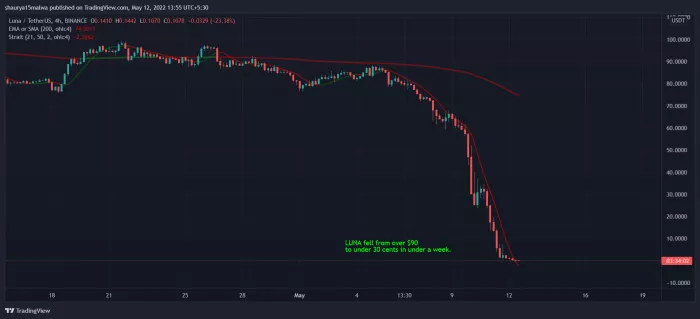After the spiral collapse of the stable currency terrausd (UST) and its sister token Luna last week, Korean coin speculators believe that the price of Luna currency has fallen and has poured into it in the near future. It is understood that both ust and Luna are virtual coins issued by Terra blockchain project established by Korean dokwon in 2018. After last week's ust unexpected thunderstorm, the value of the sister token Luna used to absorb the impact of ust price has almost completely evaporated.
According to elliptic, a blockchain analysis company, these two tokens cost investors about $42 billion. The collapse of ust and Luna also caused chaos to the global cryptocurrency market and lost about a quarter of the value of bitcoin, the world's largest cryptocurrency, between May 9 and 12.

However, Luna's price collapse did not make speculators retreat, but let a large number of speculators buy one after another, and bet that this token, once worth nearly $100 at the end of April, will usher in a miraculous recovery. Some even believe that the value of this token is "too big to fall".
A hopeful investor wrote on the blog of naver, a South Korean Internet platform: "Luna was once the top 10 currency in the market value of virtual currency, so they will revive it at all costs". He added that he bought 300000 Lunas at the price of 0.33 won (about US $0.0003) each through the international cryptocurrency exchange over the weekend.
The sudden upsurge of speculation also made the South Korean Financial Services Commission (FSC) vigilant and warned people not to invest in Luna on Tuesday.
According to a source from the FSC, as of May 15, the number of investors in this virtual currency increased by more than 50% to 280000 in just two days on South Korea's major exchanges. The source said that although some funds flowed from abroad, the purchase mainly came from domestic speculators.
However, due to the limited speculative window, the purchase of funds has little impact on the price of the token. Luna has been hovering between 0.0001 and 0.0004 cents in the past week. Earlier, bithumb and upbit, South Korea's two largest exchanges, said they would suspend trading support for Luna on May 27 and May 20, respectively, while coinone, another South Korean exchange, had stopped trading Luna.
Save Terra ecosystem
Due to the enthusiasm of the market for volatile and risky assets such as stocks and cryptocurrencies, Luna and ust were among the top ten cryptocurrencies in the world in terms of market value at an early stage. But on May 10, when the one-to-one "stable peg" between ust and the US dollar was broken, everything seemed to fall apart.
Unlike stable currencies supported by cash and assets to maintain value (such as tether and USD coin), algorithmic stable currencies such as ust have no asset support, but maintain value through arbitrage relationship with another cryptocurrency.
If the price is less than US $1, traders can convert this currency into Luna and increase the price of ust by reducing supply. On the contrary, if the price of ust exceeds US $1, traders can convert Luna into ust to ensure that ust is linked to US $1.
But this mechanism has not worked during the past slump. Algorithmic stable currency relies on traders to push the price back to $1. If traders are unwilling to buy, the currency will fall into a "death vortex".
As the market collapsed, hundreds of angry retail investors told their tragic experiences on social media, and some even asked Kwon to compensate for the losses. The Luna foundation guard fund founded by Kwon once said on twitter that in order to save UST, it had spent almost all its reserve bitcoin last week, but the value of ust currency had not recovered, which meant that Terra's efforts had completely failed.
However, Kwon did not give up and proposed "recovery plan 2" to save Terra ecosystem, which will take effect after token holders vote. Kwon promised that the voting would begin on May 18. If approved, the new Luna blockchain will go online on May 27.